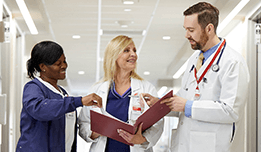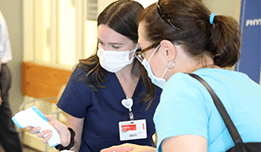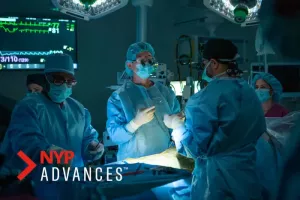Health Library
Langerhans Cell Histiocytosis Treatment (PDQ®): Treatment - Patient Information [NCI]
- General Information About Langerhans Cell Histiocytosis (LCH)
- Stages of LCH
- Treatment Option Overview for LCH
- Treatment of Low-Risk LCH in Children
- Treatment of High-Risk LCH in Children
- Treatment of Progressive, Refractory, or Recurrent Childhood LCH in Children
- Treatment of LCH in Adults
- To Learn More About Langerhans Cell Histiocytosis
- About This PDQ Summary
General Information About Langerhans Cell Histiocytosis (LCH)
Langerhans cell histiocytosis is a rare disorder that can damage tissue or cause lesions to form in one or more places in the body.
Langerhans cell histiocytosis (LCH) is a rare disease that begins in LCH cells. LCH cells are a type of dendritic cell that normally helps the body fight infection. Sometimes mutations (changes) develop in genes that control how dendritic cells function. These include mutations of the BRAF, MAP2K1, RAS, and ARAF genes. These mutations may cause too many LCH cells to grow and build up in certain parts of the body, where they can damage tissue or form lesions.
It is not known whether LCH is a form of cancer or a cancer-like disease.
Doctors who treat cancer also treat LCH, and sometimes they use cancer therapies to treat this disease. For more information, see the sections on the treatment of LCH in children and the treatment of LCH in adults.
Family history of cancer or having a parent who was exposed to certain chemicals may increase the risk of LCH.
Anything that increases a person's risk of getting a disease is called a risk factor. Not every child with one or more of these risk factors will develop LCH, and it will develop in some children who don't have any known risk factors. Talk with your doctor if you think you may be at risk.
Risk factors for LCH may include the following:
- Having a parent who was exposed to certain solvents.
- Having a parent who was exposed to metal, granite, or wood dust in the workplace.
- Having a family history of cancer or LCH.
- Having a personal history or family history of thyroid disease.
- Having infections as a newborn.
- Smoking, especially in young adults.
- Being Hispanic.
- Not being vaccinated as a child.
The signs and symptoms of LCH depend on where it is in the body.
These and other signs and symptoms may be caused by LCH or by other conditions. Check with your doctor if you or your child have any of the following:
Bone
Signs or symptoms of LCH that affects the bone may include:
- Swelling or a lump over a bone, such as the skull, jawbone, ribs, pelvis, spine, thigh bone, upper arm bone, elbow, eye socket, or bones around the ear.
- Pain where there is swelling or a lump over a bone.
Children with LCH lesions in bones around the ears or eyes have a high risk of diabetes insipidus and other central nervous system diseases.
Skin and nails
LCH in infants may affect the skin only. In some cases, skin-only LCH may get worse over weeks or months and become a form called high-risk multisystem LCH.
In infants, signs or symptoms of LCH that affects the skin may include:
- Flaking of the scalp that may look like "cradle cap."
- Flaking in the creases of the body, such as the inner elbow or perineum.
- Raised skin rash with brown or purple areas that occur anywhere on the body.
In children and adults, signs or symptoms of LCH that affects the skin and nails may include:
- Flaking of the scalp that may look like dandruff.
- Raised skin rash with red, brown, or crusted areas that may be itchy or painful. The rash can occur in the groin area or on the abdomen, back, or chest.
- Bumps or ulcers on the scalp.
- Ulcers behind the ears, under the breasts, or in the groin area.
- Fingernails that fall off or have discolored grooves that run across the nail.
Mouth
Signs or symptoms of LCH that affects the mouth may include:
- Swollen gums.
- Sores on the roof of the mouth, inside the cheeks, or on the tongue or lips.
- Teeth that become uneven or fall out.
Lymph nodes and thymus
Signs or symptoms of LCH that affects the lymph nodes or thymus may include:
- Swollen lymph nodes.
- Cough, trouble breathing, or fast breathing.
- Superior vena cava syndrome. This can cause coughing, trouble breathing, and swelling of the face, neck, and upper arms. For more information, see Cardiopulmonary Syndromes.
Endocrine system
Signs or symptoms of LCH that affects the pituitary gland may include:
- Diabetes insipidus. This can cause a strong thirst and frequent urination.
- Slow growth.
- Early or late puberty.
- Being very overweight.
Signs or symptoms of LCH that affects the thyroid may include:
- Swollen thyroid gland.
- Hypothyroidism. This can cause tiredness, lack of energy, being sensitive to cold, constipation, dry skin, thinning hair, memory problems, trouble concentrating, and depression. In infants, this can also cause a loss of appetite and choking on food. In children and adolescents, this can cause behavior problems, weight gain, slow growth, and late puberty.
- Trouble breathing.
Eye
Signs or symptoms of LCH that affects the eye may include:
- Vision problems or blindness.
Central nervous system (CNS)
Signs or symptoms of LCH that affects the CNS (brain and spinal cord) may include:
- Loss of balance, uncoordinated body movements, and trouble walking.
- Trouble speaking.
- Trouble seeing.
- Headaches.
- Changes in behavior or personality.
- Memory problems.
These signs and symptoms may be caused by lesions in the CNS or by CNS neurodegenerative syndrome.
Liver and spleen
Signs or symptoms of LCH that affects the liver or spleen may include:
- Swelling in the abdomen caused by a buildup of extra fluid.
- Trouble breathing.
- Yellowing of the skin and whites of the eyes.
- Itching.
- Easy bruising or bleeding.
- Feeling very tired.
- Diarrhea.
- Bloody stools.
Lung
Signs or symptoms of LCH that affects the lung may include:
- Collapsed lung. This condition can cause chest pain or tightness, trouble breathing, feeling tired, and a bluish color to the skin.
- Trouble breathing, especially in adults who smoke.
- Dry cough.
- Chest pain.
Bone marrow
Signs or symptoms of LCH that affects the bone marrow may include:
- Easy bruising or bleeding.
- Fever.
- Frequent infections.
Tests that examine the organs and body systems where LCH may occur are used to diagnose LCH.
In addition to asking about your health history and doing a physical exam, your doctor may perform the following tests and procedures to diagnose LCH or conditions caused by LCH:
- Complete blood count (CBC) with differential: A procedure in which a sample of blood is drawn and checked for the following:
- The amount of hemoglobin (the protein that carries oxygen) in the red blood cells.
- The portion of the blood sample made up of red blood cells.
- The number and type of white blood cells.
- The number of red blood cells and platelets.
- Blood chemistry studies: A procedure in which a blood sample is checked to measure the amounts of certain substances released into the body by organs and tissues in the body. An unusual (higher or lower than normal) amount of a substance can be a sign of disease.
- Liver function test: A blood test to measure the blood levels of certain substances released by the liver. A high or low level of these substances can be a sign of disease in the liver.
- BRAFgene testing: A laboratory test in which a sample of blood or tissue is tested for certain mutations in the BRAF gene.
- Urinalysis: A test to check the color of urine and its contents, such as sugar, protein, red blood cells, and white blood cells.
- Water deprivation test: A test to check how much urine is made and whether it becomes concentrated when little or no water is given. This test is used to diagnose diabetes insipidus, which may be caused by LCH.
- Bone marrow aspiration and biopsy: The removal of bone marrow and a small piece of bone by inserting a hollow needle into the hipbone. A pathologist views the bone marrow and bone under a microscope to look for signs of LCH.
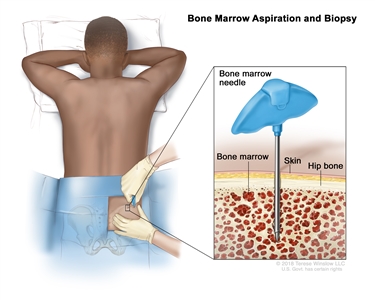
Bone marrow aspiration and biopsy. After a small area of skin is numbed, a long, hollow needle is inserted through the patient's skin and hip bone into the bone marrow. A sample of bone marrow and a small piece of bone are removed for examination under a microscope.The following test may be done on the tissue that was removed:
- Immunohistochemistry: A laboratory test that uses antibodies to check for certain antigens (markers) in a sample of a patient's tissue. The antibodies are usually linked to an enzyme or a fluorescent dye. After the antibodies bind to a specific antigen in the tissue sample, the enzyme or dye is activated, and the antigen can then be seen under a microscope. This type of test is used to help diagnose cancer and to help tell one type of cancer from another type of cancer.
- Bone scan: A procedure to check if there are rapidly dividing cells in the bone. A very small amount of radioactive material is injected into a vein and travels through the bloodstream. The radioactive material collects in the bones with LCH and is detected by a scanner.
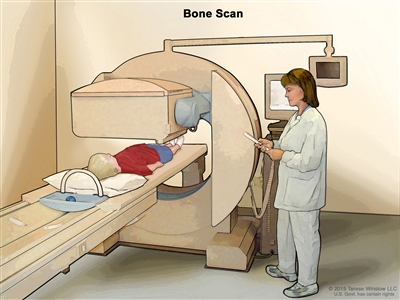
Bone scan. A small amount of radioactive material is injected into the child's vein and travels through the blood. The radioactive material collects in the bones. As the child lies on a table that slides under the scanner, the radioactive material is detected and images are made on a computer screen. - X-ray: An x-ray of the organs and bones inside the body. An x-ray is a type of energy beam that can go through the body and onto film, making a picture of areas inside the body. Sometimes a skeletal survey is done. This is a procedure to x-ray all the bones in the body.
- CT scan (CAT scan): A procedure that makes a series of detailed pictures of areas inside the body, taken from different angles. The pictures are made by a computer linked to an x-ray machine. A dye may be injected into a vein or swallowed to help the organs or tissues show up more clearly. This procedure is also called computed tomography, computerized tomography, or computerized axial tomography.
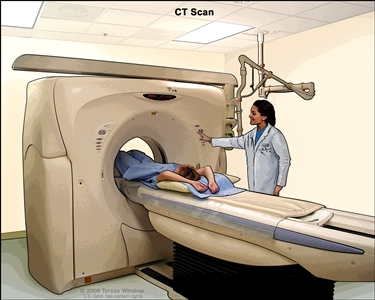
Computed tomography (CT) scan of the abdomen. The patient lies on a table that slides through the CT machine, which takes x-ray pictures of the inside of the body. - MRI (magnetic resonance imaging): A procedure that uses a magnet, radio waves, and a computer to make a series of detailed pictures of areas inside the body. A substance called gadolinium may be injected into a vein. The gadolinium collects around the LCH cells so that they show up brighter in the picture. This procedure is also called nuclear magnetic resonance imaging (NMRI).
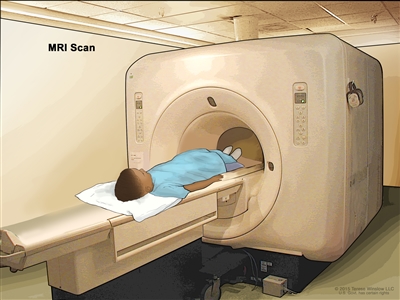
Magnetic resonance imaging (MRI) scan. The child lies on a table that slides into the MRI machine, which takes a series of detailed pictures of areas inside the body. The positioning of the child on the table depends on the part of the body being imaged. - PET scan (positron emission tomography scan): A procedure to find tumor cells in the body. A small amount of radioactive glucose (sugar) is injected into a vein. The PET scanner rotates around the body and makes a picture of where glucose is being used in the body. Tumor cells show up brighter in the picture because they are more active and take up more glucose than normal cells do.
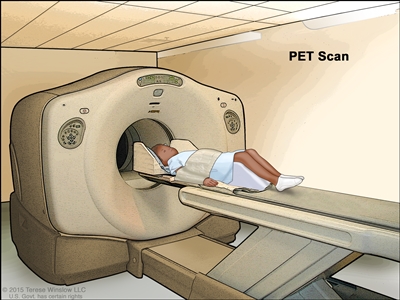
Positron emission tomography (PET) scan. The child lies on a table that slides through the PET scanner. The head rest and white strap help the child lie still. A small amount of radioactive glucose (sugar) is injected into the child's vein, and a scanner makes a picture of where the glucose is being used in the body. Cancer cells show up brighter in the picture because they take up more glucose than normal cells do. - Ultrasound exam: A procedure in which high-energy sound waves (ultrasound) are bounced off internal tissues or organs and make echoes. The echoes form a picture of body tissues called a sonogram. The picture can be printed to be looked at later.
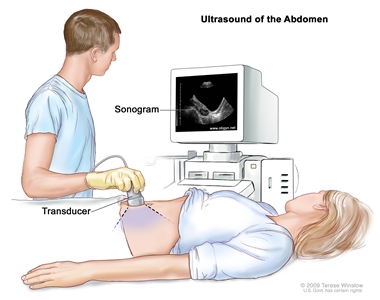
Abdominal ultrasound. An ultrasound transducer connected to a computer is passed over the surface of the abdomen. The ultrasound transducer bounces sound waves off internal organs and tissues to make echoes that form a sonogram (computer picture). - Pulmonary function test (PFT): A test to see how well the lungs are working. It measures how much air the lungs can hold and how quickly air moves into and out of the lungs. It also measures how much oxygen is used and how much carbon dioxide is given off during breathing. This is also called lung function test.
- Bronchoscopy: A procedure to look inside the trachea and large airways in the lung for abnormal areas. A bronchoscope is inserted through the nose or mouth into the trachea and lungs. A bronchoscope is a thin, tube-like instrument with a light and a lens for viewing. It may also have a tool to remove tissue samples, which are checked under a microscope for signs of LCH.
- Endoscopy: A procedure to look at organs and tissues inside the body to check for abnormal areas in the gastrointestinal tract or lungs. An endoscope is inserted through an incision (cut) in the skin or opening in the body, such as the mouth. An endoscope is a thin, tube-like instrument with a light and a lens for viewing. It may also have a tool to remove tissue or lymph node samples, which are checked under a microscope for signs of disease.
- Biopsy: The removal of cells or tissues so they can be viewed under a microscope by a pathologist to check for LCH cells. To diagnose LCH, a biopsy of bone, skin, lymph nodes, liver, or other sites of disease may be done.
Certain factors affect prognosis (chance of recovery) and treatment options.
LCH in organs such as the skin, bones, lymph nodes, or pituitary gland usually gets better with treatment and is called "low-risk." LCH in the spleen, liver, or bone marrow is harder to treat and is called "high-risk." Children with LCH in high-risk organs and the gastrointestinal tract have a greater risk of not responding to treatment than patients with high-risk LCH and no disease in the gastrointestinal tract. High-risk LCH is usually seen in children younger than 2 years.
The prognosis and treatment options depend on the following:
- Which organs or body systems are affected by LCH.
- How many organs or body systems the LCH affects.
- Whether LCH is found in the liver, spleen, bone marrow, or certain bones in the skull.
- How quickly LCH responds to initial treatment.
- Whether there are certain mutations in the BRAF gene.
- Whether LCH has just been diagnosed or has come back (recurred).
In infants up to 1 year of age, LCH may go away without treatment.
